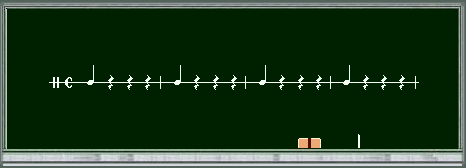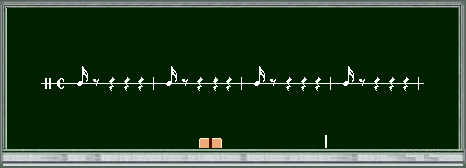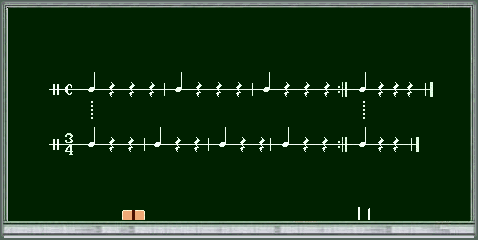First, make it a habit for each person to warm up before the ensemble. Make sure to play quietly to warm up your instrument until the ensemble starts.
Ensemble basic practice will also proceed according to the music score. Reading music is also a form of basic practice. Each band should decide the content to some extent, so that students can do it by themselves.
When the teacher can hear, find mistakes and redo them or add what is needed, so that basic practice does not just go through each time without listening to each other's sounds.
There are several band methods published for wind bands. Choose the one that suits your band and practice it exactly as it is.
I think they are all valuable if you follow the instructions carefully.
Although it's not really written in any of the methods, it's also important to practice playing short notes together (aligning the vertical lines).
For example, play a quarter note in time with the tempo.
This is what it looks like on the sheet music.

In this form, repeat the same note or play the scale in time with the metronome
 . Be careful to match the shape of the Reverberation.
. Be careful to match the shape of the Reverberation.If you play each note shorter, for example, a sixteenth note, and louder, you can practice making the onset of the sound sharper and clearer, and you can also use more force of breath.
This is what it looks like on the sheet music.

Percussion instruments with short resonances, such as snare drums, xylophones, and wood blocks, can be used.
Start with a tempo of about 120 quarter notes and gradually increase the tempo to help you concentrate while practicing. Practice with triple beats as well.
You can have fun practicing by dividing the band into two groups by part or range, and starting one group with a four-beat and the other with a triple beat at the same time.

When playing long tones, the timing of the sound is inevitably unclear, so it is also necessary to practice concentrating on the "moment when the sound is produced." Increasing the volume will help you practice blowing with your breath, and the beginning of the sound (the rise of the sound) will become clearer.
However, as I wrote in "6. Rehearsal location and equipment needed" please do not practice while "connecting a speaker to an electric metronome and playing it at a loud volume."
When the tempo of the band starts to slow down, in most cases the teacher's conducting will also slow down to match the band. It is quite difficult to continue conducting at an accurate tempo without being outdone by the band.
For example, if the teacher continues to conduct at an accurate tempo while watching the metronome swing back and forth, or while listening to the sound of an electronic metronome through earphones, the band will gradually be able to play at an accurate tempo.
In many cases, the problem can be solved by the conductor alone.
Please practice scales not just whole notes, but up to eighth notes in march tempo.
When we think of basic practice, we tend to think of just practicing making sounds mechanically, but playing melodies in unison and playing chorales while listening to the sounds around you is also an important part of basic practice. Prepare a few chorales and practice to get used to the style of chorales.
Also, I think it would be useful to play a few easy pieces like those in the
If you are in a wind band, having a collection of marches will allow you to learn basic techniques while having fun practicing.